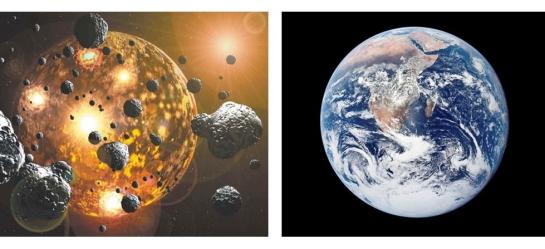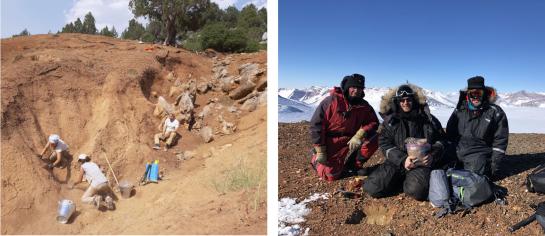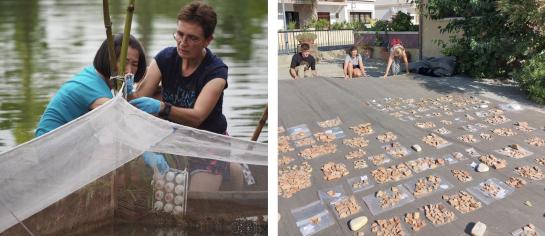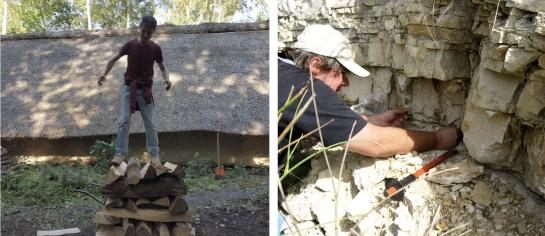



DOCUMENTING EARTH BIO-GEO-EVOLUTION
The inter-faculty AMGC research group is trans-disciplinary in nature merging expertise in archaeology & archaeological science, geology, geo- & cosmo-chemistry, anthropology, paleoenvironmental & paleoclimate reconstructions, past and present global changes, chemical engineering, analytical chemistry and environmental science to answer important questions about the past, the present, and the future of the Solar System, Planet Earth, and Humankind.
The research themes covered by AMGC relate to Planet Earth and its global evolution with a particular focus on the place and role of life in general (humans, animals, plants) together with interactions and reciprocal impacts between biotic and abiotic ecosystems. The 2 major research objectives (RO) are:
- RO1. Understand Earth formation, within the solar system, and the causes, mechanisms, consequences of the major environmental/climate/biotic changes that shaped its evolution from 4.5 billion years ago until today.
- RO2. Shed light on behavioral patterns of humans, animals, and plants, reconstruct the sociocultural organization of past communities, and document the impact of life on the environment (and reciprocally) in the past and the present, as exemplified by ongoing anthropogenic activities.
These two RO’s converge around the use of state-of-the-art analytical laboratories (Mass spectrometry, X-Ray Fluorescence, Infra-red Spectroscopy, Bio-assay…), which are part of the core facility “Material Characterization”, cross fertilizing each other through the development of innovative analytical methodologies. Research themes range from documenting the extra-terrestrial flux of materials to Earth through time, impact cratering and mass extinctions and high-resolution paleoclimate reconstructions, to landscape-, geo- and bio-archaeology in Europe and the Mediterranean, as well as monitoring pollution in soils, rivers, lakes and oceans. This union boosts a new complementary focus on how ancient human populations and societies were impacted by climate changes and, in return, how their evolution modified past environments, and landscapes.
Part of the scientific approach of AMGC focuses on the holistic use of biogeochemical tracers, such as elemental concentrations (Cd, Pb, PGE etc.) and isotopic ratios (D/H, 18O/16O, 13C/12C, 15N/14N, 87Sr/86Sr...), - often referred to as "proxies" - that are measured on a substrate (e.g. mineral phase, fossil, mussel-shell, teeth, seawater, plankton, ice cores etc.) to infer specific environmental parameters (such as condition of formation, temperature, acidity, salinity, CO2 level, composition, bio-productivity etc.). Variations in these "proxies" characterize the factors triggering or resulting from (paleo)environmental changes and document at different scales, the short and/or long-term effects of these modifications on the Global Earth System. Although not commonly carried out, the analyses in close conjunction of modern and ancient global changes, including anthropogenic pollution are highly complementary and mutually beneficial. Ongoing changes are monitored and documented at very high resolution, while the geological record traces the evolution of these changes through time, providing an extra dimension, missing from the modern data. Also, concentration and isotope ratios of various elements present in bones and teeth record living conditions and migration of ancient ppopulations. To address these challenges, innovative analytical procedures are continuously being developed using the outstanding analytical facilities available at the VUB and applied to various geological, archaeological, environmental and pollution questions
Ongoing research covers:planetary science, including (micro)meteorite search expeditions in Antarctica; studies of the Chicxulub impact-crater, most likely responsible for the K-Pg mass extinction. Paleoclimate reconstructions using stable isotopes and traces elements measured at high resolution on archives such a speleothems and fossil shells. Pioneering work applying cyclostratigraphy and astrochronology to the Paleozoic to refine pas global changes timing. The detection using DGT (diffusive gradients in thin film) and tracing of trace metals in aquatic systems with applications in pollution or global change studies. The biogeochemistry (metals, 15N, 13C) of marine and river (Schelde; Zenne) systems. The development of chemometric methods, together with the use of Calux bioassays systems for estrogen, doxin and other organic pollutants detection in various matrices (food; human fluids, water etc). AMGC is also active in geo-bio- and landscape-archaeology, using state-of-the-art field research and innovative laboratory analyses to reconstruct mobility, landscape use and diet in ancient populations (see BBLab or IsoArch database. By doing so AMGC traces different episodes of growth, decline, collapse and resilience within human groups and their drivers.
